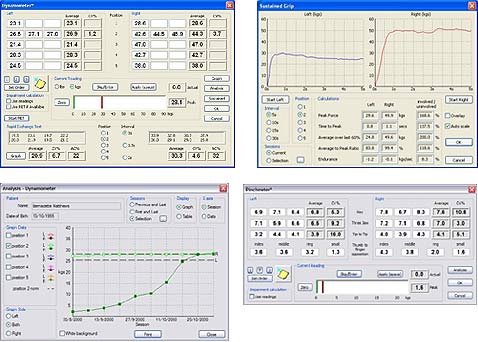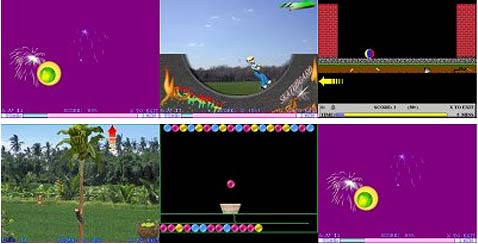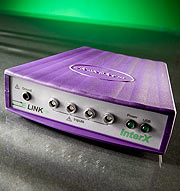E-LINK H500 Hand Kit
Standardized pinch and grip measurements with precise electronic tools for evaluation and progress reporting. Unique pinch and grip exercises giving purposeful activity, isometric strengthening, motor learning and control.
Grip & Pinch Strength Evaluation
Biometrics' computerised tools for strength evaluation and exercise measure in 0.1 increments (Kg or lbs) and include tests that cannot be done with manual devices. In addition to speeding up data collection, they are extremely sensitive providing accurate measurement on very weak or debilitated patients.

The precision Biometrics' Dynamometer linked to the E-LINK software easily and accurately measures grip strength:
- Standard Peak Force Grip test with automatic calculation of average and coefficient of variation
- Sustained grip test measures force over time in 5, 10, 15, and 30 sec intervals and calculates peak force, time to peak, average, and fatigue rate. Graphically compare the current test with a prior session.
- Rapid exchange test, for detection of sub-maximal effort, is easily performed and the results documented in both graph and table form
- Progress reporting over multiple sessions, in both graph and table form, with calculation of percentage change from session to session, and comparison with standard Jamar normal values (adult and pediatric normal values included)
The unique low profile design of the Biometrics' Pinchmeter allows measurement and exercise at closer to end range than any other device - manual or electronic. The software accurately and easily measures pinch strength:
- Key (Lateral), Three Jaw (Tri-pod), Tip to Tip - three trials per position, calculates average and co-efficient of variation
- Thumb to Digit Opposition
- Sustained pinch test measures force over time in 5, 10, 15, and 30 sec intervals and calculates peak force, time to peak, average, and fatigue rate. Graphically compare the current test with a prior session.
- Progress reporting over multiple sessions, in both graph and table form, with calculation of percentage change from session to session

Unique Isometric Grip & Pinch Exercise
As opposed to traditional zero to peak force exercises, the range of force may be graded, setting the minimum and maximum, to meet the patient's functional goals. Force ranges for exercise are set in 0.1 increments with a maximum load of 90 Kg (200 lbs) for grip and 22 Kg (50 lbs) for pinch. The movement of the objects in the E-LINK Activity Modules is controlled by the application and relaxation of isometric grip or pinch within the set parameters. The various modules provide purposeful activity, isometric strengthening, motor learning and control.

The range of force settings and activities allow multiple exercise options such as:
- zero to peak force exercise, taking the patient from full relaxation to maximum, including the option to hold at peak force.
- exercise within patient limitations, setting the minimum at greater than zero, causing the patient to sustain the pinch or grip and control the force application and relaxation.
- setting the force range very low allows controlled purposeful activity while minimizing joint loading. This is useful for patients with Arthritis and other situations where low force on the joints is desirable.
- patients with spasticity can work on controlled relaxation within therapist-defined ranges.
- by varying the range of force and time, the patient's rehabilitation can be oriented to specific job or ADL goals.

The R500 requires the InterX Unit as the interface to the computer.


